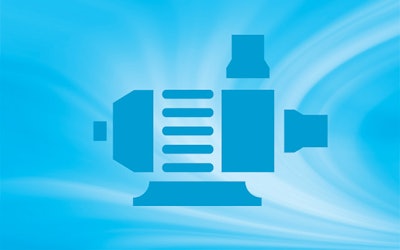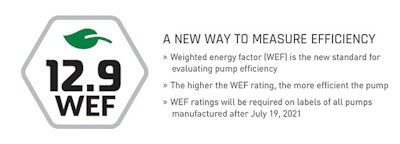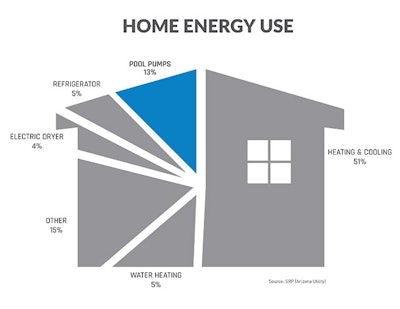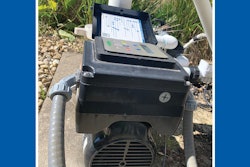
The upcoming Department of Energy (DOE) regulations for pool pumps will change the U.S. pool market more so than any other issue in recent memory. All manufacturers, domestic and foreign, must comply with the regulations that go into effect on July 19, 2021. Products made before this date can be sold throughout the channel, and existing inventory does not need to be returned. However, all pumps made after this date must meet the new DOE energy efficiency criteria.
These requirements are based in large part on a new metric named Weighted Energy Factor, often referred to simply as WEF. WEF is the first industry-wide efficiency metric and will make it easier for consumers and pool professionals to evaluate and compare the energy efficiency of pool pumps.

BACKGROUND
Pool pumps often consume the second largest amount of household energy after heating and air conditioning and so have been part of pool efficiency measures for some time.
The origins of WEF can largely be traced to the California Energy Commission's (CEC) Appliance Efficiency Regulations, often referred to as "Title 20," that have been in place for pool pumps for over a decade. While Title 20 prescriptively requires the type of pump motor used (two or more speeds for 1.0 total horsepower and above), it also requires manufacturers to provide data on each listed model including Energy Factor, which is the ratio of flow divided by power and where higher is better (more efficient). Energy Factor is effectively how much "bang for your buck" is delivered by a pump — in other words, how much water (flow) it can provide for a given amount of energy consumption.
Efficiency = Output/Input = Bang/Buck
The development of the DOE regulation started in 2015, and it was soon noted that Energy Factor, while useful, could be a misleading value as there are no limitations on how it is measured. For instance, it could be calculated at a speed that delivers an impractical flow such as 10 GPM or less. This led to the development of WEF, which is the weighted mix of Energy Factors at different speeds along with minimum flow requirements. The WEF for a single-speed pump is the same as Energy Factor, since there is only one speed at which to measure. For two-speed and variable-speed pumps, WEF is weighted at 80% of the low speed Energy Factor and 20% of high speed.

SIMILAR TO OTHER INDUSTRIES
Many other industries utilize minimum efficiency requirements and have, in turn, developed efficiency metrics that are a key factor in product selection. Notable examples that are very similar to WEF are Miles per Gallon (MPG) for vehicles or Seasonal Energy Efficiency Ratio (SEER) for air conditioning units. MPG is a vehicle's efficiency and is calculated by dividing the distance driven by the amount of fuel consumed. The more miles you are able to drive on a tank of gas, the more efficient the vehicle. Air conditioning units now have a SEER that is calculated by dividing the amount of cooling produced (BTU) by the amount of electricity (watts) used. The more cooling produced by a watt of electricity, the more efficient the air conditioning unit.
RELATED: New DOE Rules Set to Eliminate Many Single-Speed Pool Pumps
Both MPG and SEER are based on a standard set of conditions to assure consistency in measurements and, in turn, comparisons between products. This means the base product is efficient but its actual energy consumption is still dependent on usage — your energy bill depends as much on what temperature you set the AC as the SEER rating. The value of these metrics is that it's an apples-to-apples comparison: Under the same conditions, a pump with a higher WEF will save more energy — and money — than a pump with a lower WEF.
As a point of reference in regards to the scale current industry WEF ratings span, larger single-speed pumps that do not meet the minimum DOE requirements are rated around 2.0 while the highest rated (most efficient) pumps per published ENERGY STAR data are currently rated at 12.9. There's no doubt manufacturers will strive to improve their WEF efficiency ratings as product technologies and innovations continue to move forward.

WHAT MAKES A GOOD WEF?
As noted, WEF is a weighted mix at different speeds (high and low) when applicable. For a given pump design, the WEF for a two-speed pump will be higher than a single speed because it can take into account the higher Energy Factor at low speed. In turn, a comparable variable-speed pump will have an even higher WEF, assuming it can operate below 50% of maximum speed and still meet the minimum flow requirements.
The DOE does not actually specify that variable-speed pumps must be used for self-priming (e.g. in-ground) applications. Instead, it requires a minimum WEF that, above a certain size (fl ow) and based on today's technology, only a variable-speed pump will comply. This performance-based metric encourages manufactures to continue developing more efficient products, rather than being required to follow a purely prescriptive approach.
Since WEF is the measure of energy efficiency, it makes sense that a variable-speed pump would carry a higher rating than a single-speed pump. But what makes the WEF of one variable-speed different from another variable-speed?
RELATED: The New DOE Pump Regs: Introducing Hydraulic Horsepower
WEF is the overall efficiency of a pool pump which, in turn, is comprised of the electrical (e.g. motor) and hydraulic (wet end) system. Most variable-speed pumps in the market are based on existing single-speed designs, often with the same hydraulics but with a new variable-speed motor and drive. Understandably, it is the new motor and drive that gathers attention as they, by changing speed, deliver tremendous energy savings vs. a single speed pump that only runs at 100% all of the time. Often, the biggest difference between individual variable-speed models, however, is the efficiency of the wet end – how well it converts the energy from the motor into moving water.
WEF will be physically labeled on each pump so that users can easily compare its energy efficiency to other models, similar to how new vehicles and air conditioners are marked with their respective efficiency ratings. Pumps will also still have horsepower ratings but using a method that is different than has traditionally been used in most pool markets.

A HORSE BY ANY OTHER NAME
Pumps and motors have long been rated in terms of horsepower (HP) along with an associated service factor. Unfortunately, this has led to disparities within the industry where certain markets utilize full-rate models (higher service factor, lower-rated HP) or max-rate/up-rate versions (lower service factor, higher-rated HP). The DOE regulation requires manufacturers to only rate and label pumps using total horsepower (THP), which is the horsepower based on a fixed service factor of 1.0. This will eliminate the full-rate and max-rate methodology and create a consistent comparison across models.
Another new term from the regulation is hydraulic horsepower (HHP), which is not the same as total horsepower as it's directly proportional to pump head and flow. Unlike WEF and total HP, the DOE does not require manufacturers to label HHP on the product, since its primary use is in the calculation of the minimum WEF manufacturers must meet to comply with the regulation.
RELATED: DOE Releases Preliminary Draft of Upcoming Motor Rule
Higher efficiency does not equal limited performance. Energy-efficient vehicles may bring to mind the original hybrids from 10 years ago that may have sacrificed acceleration for the sake of energy conservation. Today's Tesla Model S can go 0-60 mph in 2.3 seconds yet, under normal driving conditions, deliver the equivalent of over 110 MPG. Best-in-class products, whether vehicles, air conditioners or pool pumps, deliver efficiency and performance that complement one another instead of sacrificing one for the sake of the other.
HOW TO USE WEF
WEF is another aspect that pool professionals should consider when selecting a pump for a given application. You still have to factor in standard issues such as plumbing size, head and flow requirements, and physical footprint, the same as has always been done for both new and replacement installations. WEF now allows you to easily evaluate and compare the energy-efficiency of pool pumps and, in turn, provide the best solutions for the consumer.
We can once again look to the HVAC industry that has already gone through the shift to minimum efficiency requirements on how to leverage efficiency ratings. My family recently needed to purchase a new air conditioning unit and, like many, we wanted to balance energy savings with the out-of-pocket expense. We relied on our contractor's experience with different brands and sizing the unit; however, he did provide us options on different SEER ratings so that we could make an informed decision about energy efficiency. Energy efficiency is not the only factor to consider, but it is an important one that should not be ignored as consumers are more and more aware of the benefits and options available from which to choose and are becoming more educated on the total cost of ownership of a pump purchase as it relates to the typically much larger energy costs over its lifetime.
Pool builders, servicers and retailers can gain an advantage by proactively educating their customers about the new DOE standards and WEF ratings. Selling DOE-compliant pumps — many of which will be variable-speed models — is a win-win scenario for pool professionals and consumers. When it comes to selling compliant variable-speed models, pool pros will benefit financially because of their higher price point, while consumers will save energy and money from the increased efficiency — plus, they'll enjoy other benefits like noticeably quieter operation. Compliance with the new DOE regulations is mandatory, so it's beneficial to prepare early and maximize selling opportunities.
KEY TAKEAWAYS
The DOE is regulating pools pumps and Weighted Energy Factor will be the primary basis for compliance and just as important, the measure of overall energy efficiency. DOE-compliant pumps provide the same installation and performance requirements needed to successfully operate pools and spas while, at the same time, delivering significant energy savings. Just as MPG ratings led consumers to choose more efficient vehicles, WEF labeling is expected to increase consumer preference and sales of energy-efficient pool pumps.
Scott Petty is the global product manager for pumps at Hayward Industries, and has been instrumental in the development and guidance of the new regulatory requirements along with other partnering manufacturers. For more information, please visit hayward.com/regulations.











































